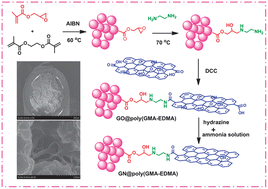A strategy to decorate porous polymer monoliths with graphene oxide and graphenenanosheets
Abstract
Graphene oxide (GO)/

* Corresponding authors
a
College of Chemistry, Jilin University, Qianjin Street 2699#, Changchun, 130012 P. R. China
E-mail:
jiaqiong@jlu.edu.cn
b Jilin Entry-Exit Inspection and Quarantine Bureau, Changchun 130062, China
Graphene oxide (GO)/

 Please wait while we load your content...
Something went wrong. Try again?
Please wait while we load your content...
Something went wrong. Try again?
S. Tong, X. Zhou, C. Zhou, Y. Li, W. Li, W. Zhou and Q. Jia, Analyst, 2013, 138, 1549 DOI: 10.1039/C2AN36608H
To request permission to reproduce material from this article, please go to the Copyright Clearance Center request page.
If you are an author contributing to an RSC publication, you do not need to request permission provided correct acknowledgement is given.
If you are the author of this article, you do not need to request permission to reproduce figures and diagrams provided correct acknowledgement is given. If you want to reproduce the whole article in a third-party publication (excluding your thesis/dissertation for which permission is not required) please go to the Copyright Clearance Center request page.
Read more about how to correctly acknowledge RSC content.
 Fetching data from CrossRef.
Fetching data from CrossRef.
This may take some time to load.
Loading related content
